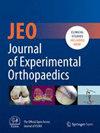High prevalence of femoral and tibial torsional abnormalities in female patients with anterior knee pain resistant to conservative treatment: A CT-based study
Abstract
Purpose
To assess acetabular version (AV) and to determine the prevalence of femoral and tibial torsional abnormalities in female patients with anterior knee pain (AKP) unresponsive to conservative treatment. The study also aimed to evaluate the prevalence of combined abnormalities.
Methods
Seventy-three AKP female patients resistant to conservative treatment evaluated between 2013 and 2024 were included. Torsional computed tomography (CT) of the lower limbs was performed on all cases, resulting in the evaluation of 146 limbs. Femoral anteversion (FAV) was measured using Murphy's method, external tibial torsion (ETT) using Jend's technique and AV using the method described by Tönnis and Heinecke.
Results
Torsional abnormalities were highly prevalent. Only 13.0% of limbs had normal ETT, 43.2% showed moderate abnormalities and 43.8% severe abnormalities. FAV was within normal limits in 48.6% of cases, while 26.7% had moderate anteversion, 22.6% severe anteversion and 2.1% retroversion. AV was normal in 82.9% of limbs, with 13.7% showing retroversion and 3.4% anteversion. Only 4.1% of patients exhibited normal across all three parameters, while 8.2% presented combined abnormalities. The most common paired association was observed for ETT and FAV (35.6%). Chi-squared analyses did not reveal statistically significant associations among the degrees of deformity. Pearson correlation analysis showed a weak but statistically significant correlation between ETT and FAV (r = 0.176, p = 0.034).
Conclusion
In young female patients with AKP unresponsive to conservative treatment, assessment of femoral and tibial torsion using CT imaging should be systematically considered. This approach is essential for guiding clinical decision-making. The range of possible torsional abnormalities highlights the importance of patient-specific evaluation.
Level of Evidence
Level IV.


 求助内容:
求助内容: 应助结果提醒方式:
应助结果提醒方式:


